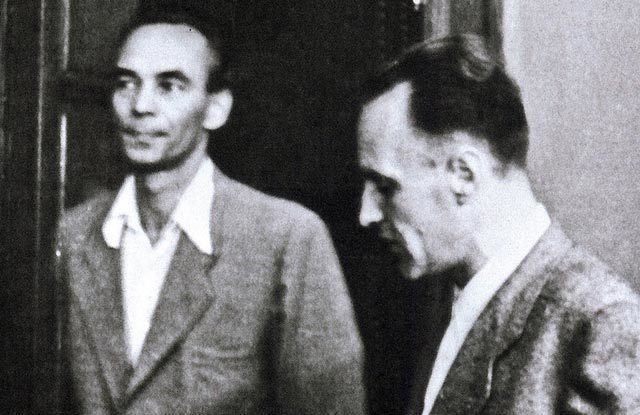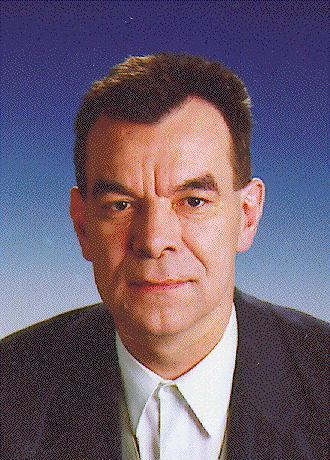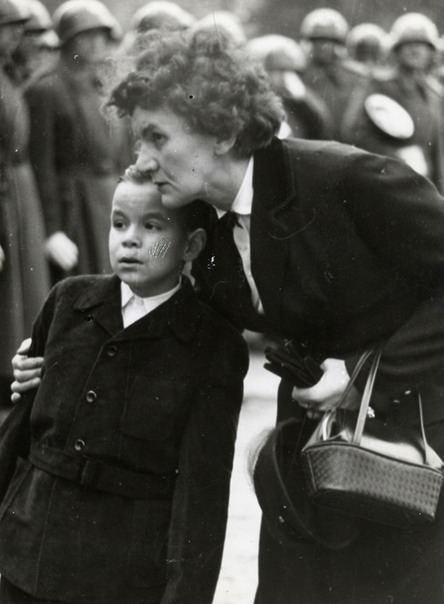Succeeded by Janos Kadar Role Hungarian Politician | Name Laszlo Rajk Profession politician Children Laszlo Rajk | |
 | ||
Born 8 March 1909Szekelyudvarhely, Udvarhely County, Kingdom of Hungary, Austria-Hungary (now Odorheiu Secuiesc, Romania) ( 1909-03-08 ) Political party Hungarian Communist Party, Hungarian Working People\'s Party Similar People Lajos Kossuth, Attila Jozsef, Endre Ady, Mihaly Babits, Mihaly Vorosmarty | ||
Prof andras gollner introduces laszlo rajk at concordia university
László Rajk (March 8, 1909 – October 15, 1949) was a Hungarian Communist politician, who served as Minister of Interior and Minister of Foreign Affairs. He was an important organizer of the Hungarian Communists' power (for example, organizing the State Protection Authority (ÁVH)), but he eventually fell victim to Mátyás Rákosi's show trials.
Contents
- Prof andras gollner introduces laszlo rajk at concordia university
- Background
- Trial
- Post trialreburial
- List of defendants in the Rajk trial
- Play
- L szl rajk on confronting the past in hungary and the disgusting campaign against refugees
- References

Background

Born in Székelyudvarhely, the ninth of eleven children in a family of Transylvanian Saxons, his ties to Communism began at an early age when he became a member of the Communist Party of Hungary (KMP).

Later he was expelled from his university for his political ideas and would become a building worker, until 1936 when he joined the Popular Front in the Spanish Civil War. He became commissar of the Rakosi Battalion of XIII International Brigade. After the collapse of Republican Spain, he was interned in France until 1941, when he was finally able to return to Hungary, where he became Secretary of the Communist Party Central Committee, an underground Communist movement.

In December 1944 he was arrested by a detachment of the Arrow Cross Party. He was to be executed, and was transported to the prison of Sopronkőhida, then into Germany; but the intercession of his elder brother, Endre, a fascist under-secretary saved his life. László Rajk was released on May 13, 1945.

He went home to Hungary and took part in party politics. He became a member of all the leader corporations of the party (MKP) and the Extemporal Parliament. Rajk was a member of the High National Council from December 7, 1945 to February 2, 1946. On March 20, 1946 he was appointed to be the minister of the Interior. In this post he organized the Hungarian Communist Party's private army and secret police (an organization analogous to the KGB, Securitate, Stasi and so on), the ÁVH (originally AVO), and he became directly responsible for this. Under the cover of "struggle against fascism and reaction" and "defence of the power of proletariat", he prohibited and liquidated several religious, nationalist, and maverick establishments and groups (the number of these was about 1,500), and set up the first show trials.

He was reassigned from the Ministry of the Interior to the Ministry of Foreign Affairs from August 5, 1948 to May 30, 1949. Rákosi, who saw Rajk as a threat to his power, decided to accuse him on false charges and had him arrested on May 30, 1949 on trumped up charges. Rajk, who was popular among the Communists before, soon became the "chained dog" of Tito, Horthy and "the imperialist".
Trial
László Rajk was accused of being a "Titoist Spy", an agent for western imperialism and one who planned on restoring capitalism and jeopardizing Hungary's independence. During his time in prison, Rajk was tortured and was promised acquittal if he took responsibility for the charges brought against him. Stalin's NKVD emissary coordinated with Hungarian General Secretary Mátyás Rákosi and his ÁVH to orchestrate Rajk's show trial.
At his trial, held between September 16 and September 24, 1949, in the large assembly hall of the headquarters of the Metal and Engineering Workers' Trade Union in Budapest, he confessed to all the charges brought against him. After his confession the prosecution decided, against the promise made, to call for the heaviest sentences to be brought down upon him and the other seven men who stood trial with him. Rajk was to be made an example for the beginning of Stalin's anti-Titoist purges. Rajk, along with Drs Tibor Szönyi and András Szalai, was sentenced to death. Rajk was executed on October 15, 1949.
One key defendant was Dr Tivadar Komáromi, who had been a Foreign Office official during the German Occupation. He was later arrested on a trumped up charge, and sentenced to five years of hard labor. In 1956 he, his wife and their two young children, managed to cross the Hungarian/Austrian border in October 1956, and with the help of Quakers, found refuge in England.
Post-trial/reburial
The Rajk trial marked the beginning of the anti-Titoist drive movement of Stalin. His trial also marked the beginning of the removal of all political parties in Hungary. The purges, however, left the economy in a truly disastrous state whereby a lack of capital inflow doomed the building projects that were underway. A vast number of the intelligentsia were then employed on the sort of manual labouring duties usually reserved for skilled professionals. The result left the country with an inadequate infrastructure and unsatisfactorily manufactured goods. The government was also using too many men to search for spies within the country and not enough to perform the productive work to sustain the economy.
Dissatisfaction with Rákosi's rule began to surface. On 28 March 1956, following numerous demonstrations, Rajk was rehabilitated. The rehabilitation speech, even though it was not publicized, had vast consequences for Rákosi, who had used the Rajk guilt as an explanation for the other purges that followed. Now that he had to admit that he was, indeed, wrong, it would end up ruining Rákosi's rightful authority. Lászlo Rajk was then reburied, before 100,000 mourners, on October 6, 1956, along with two other men who lost their lives during the purges. (This was a precursor to the Hungarian Revolution of 1956, which began on 23 October.)
List of defendants in the Rajk trial
15 people were executed and 78 others were sentenced to prison in relation to the Rajk case.
Play
László Rajk: the events of his political and family life, beginning circa 1945, his trial, execution, reburial, atonement, and ending with the Hungarian Revolution of 1956 and Russia's armed invasion of Hungary, are all portrayed in Robert Ardrey's 1958 play, Shadow of Heroes.
